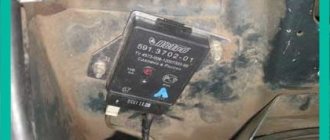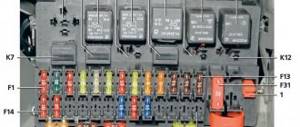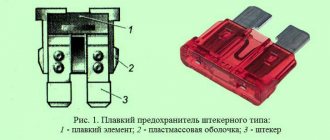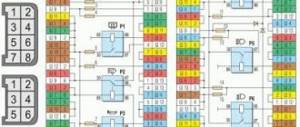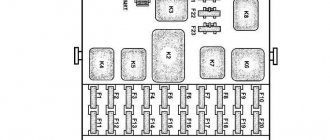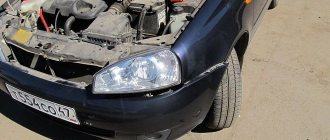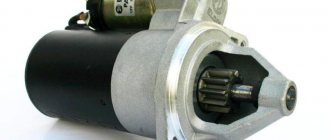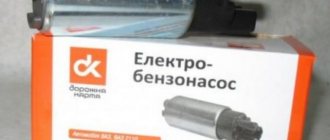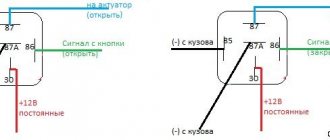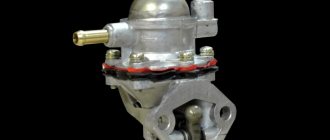VAZ turn signal relay - do-it-yourself diagnostics and replacement
Turn signals are perhaps a very important part of any vehicle. Carrying out maneuvers on the road becomes quite a dangerous task if the turn signals do not work. The VAZ 2107 turn signal and hazard warning relay is responsible for the correct operation of the direction indicators. This device is used on all cars of the classic family. Let's consider why a turn signal relay is needed, how is a relay malfunction determined and how is it replaced?
Purpose of the turn signal and hazard warning relays
Everyone knows that direction indicators and hazard warning lights blink during operation. This is necessary in order to attract the attention of other traffic participants. The flickering of lamps cannot be confused with any other signal supplied by lighting devices. A small device called a turn signal relay . In addition to the blinking of the turn signals, the relay provides another function - creating the necessary sound signal (click), which indicates that the turn signals are in operation.
The Zhiguli used two types of relays, which differ both in their design and in their operating principle.
- The first type is electromagnetic type relay, which is mounted in the engine compartment of the car. The basis for the operation of the electromagnetic thermal relay is a special nichrome string, which, when heated and cooled, closes and opens the direction indicator circuit. These types of relays were used on early models of the “classic” family: VAZ 2101-2102 and VAZ 2103.
- The second type of relay began to be used on VAZ 2106 and higher vehicles. It is an electronic circuit built on semiconductor circuit elements. In addition to semiconductors, the relay also includes an electromagnet, which performs the functions of closing and opening. The frequency of operation of the electromagnet (or flickering of lamps) is achieved using a “key”, or a special electronic circuit.
Ignition relay VAZ 2107
The very first versions of the VAZ did not have a fuse and relay block, that is, power was supplied to the coil through the ignition switch itself. Such a motor starting system “ate up” a lot of electricity, and the contacts quickly oxidized and stopped functioning normally.
The VAZ 2107 is equipped with a modern ignition relay. Its main function is to reduce the load on the contacts when turning on the device, since the relay turns off some electrical circuits at the moment of startup. The ignition relay is used in both carburetor and injection VAZ 2107 models.
Principle of operation
The ignition relay is one of the elements of the entire ignition system. This system consists of:
- spark plugs;
- distributor;
- capacitor;
- breaker cam;
- coils;
- mounting block;
- switch.
When the engine starts, power from the spark plugs goes to the ignition relay, which switches energy from some circuits. Thanks to this, the coil is supplied with the amount of power that is necessary to start the engine normally. To ensure uniform current supply, the relay works directly with the distributor and capacitor.
Relay location in the car
Any problems with the ignition relay on a VAZ 2107 begin with the fact that the driver cannot start the engine the first time. Suspicions immediately arise regarding the performance of certain components, but, as a rule, the relay is the first thing to be checked. On the “seven” it is located immediately behind the instrument panel and is fixed under the dashboard. This arrangement cannot be called convenient, because to get to the relay, you will need to remove the entire dashboard.
Table: designations of relays and fuses
| Fuse number (rated current)* | Purpose of VAZ 2107 fuses |
| F1 (8A/10A) | Rear lights (reversing light). Reverse safety device. Heater electric motor. Heater fuse. Warning lamp and heated rear window relay (winding). Electric motor for rear window cleaner and washer (VAZ-21047). |
| F2 (8/10A) | Electric motors for wipers, windshield washers and headlights. Relay for wipers, windshield washers and headlights (contacts). Wiper fuse for VAZ 2107. |
| F3/4 (8A/10A) | Reserve. |
| F5 (16A/20A) | Rear window heating element and its relay (contacts). |
| F6 (8A/10A) | Cigarette lighter fuse for VAZ 2107. Socket for a portable lamp. |
| F7 (16A/20A) | Sound signal. Radiator cooling fan electric motor. Fan fuse for VAZ 2107. |
| F8 (8A/10A) | Direction indicators in hazard warning mode. Switch and relay-interrupter for direction indicators and hazard warning lights (in hazard warning mode). |
| F9 (8A/10A) | Fog lights. Generator voltage regulator G-222 (for some vehicles). |
| F10 (8A/10A) | Instrument cluster. Instrument panel fuse. Indicator lamp and battery charge relay. Direction indicators and corresponding warning lamps. Indicator lamps for fuel reserve, oil pressure, parking brake and brake fluid level. Voltmeter. Instruments of the carburetor electro-pneumatic valve control system. Parking brake warning light relay. |
| F11 (8A/10A) | Brake light bulbs. Lamps for interior body lighting. Brake light fuse. |
| F12 (8A/10A) | High beam (right headlight). Winding for switching on the headlight cleaner relay. |
| F13 (8A/10A) | High beam (left headlight) and high beam indicator lamp. |
| F14 (8A/10A) | Side light (left headlight and right rear light). Indicator lamp for turning on the side light. License plate lights. Engine compartment lamp. |
| F15 (8A/10A) | Side light (right headlight and left rear light). Instrument lighting lamp. Cigarette lighter lamp. Glove box lighting lamp. |
| F16 (8A/10A) | Low beam (right headlight). Headlight cleaner relay activation coil. |
| F17 (8A/10A) | Low beam (left headlight). |
| * In the denominator for pin type fuses | |
Diagnostics of malfunction of the direction indicator relay VAZ 2107
If one day the turn signals stopped working. It's time to check what happened and, if possible, replace the faulty part of the circuit. Malfunctions of the turn signal relay can be recognized by several signs:
- The turn signals light up but do not flicker . This directly indicates a breakdown of the relay, or rather, its electromagnetic part. In this case, the electromagnet has closed in one of the positions and cannot return to its original state.
- The turn signals blink too quickly or too slowly . This can happen, but not only due to the fault of the turn signal relay. Sometimes the flickering speed of lamps can change if the turn signals use lamps that are not of the same power as those specified by the manufacturer. However, it wouldn't hurt to install a new relay as a test.
- The turn signals don't work at all . This means that the turn signal lamps and the lamp on the dashboard do not blink and there are no corresponding relay clicks. However, as in the second case, the malfunction does not always concern the turn signal relay. Sometimes the reason is a faulty hazard warning button.
Where is the turn signal relay located on the VAZ-2107
Direction indicators, which are used in the design of absolutely any car, regardless of their model and brand, are designed to indicate the maneuver being performed. They allow other road users to immediately know that you intend to turn and are quite capable of preventing a traffic accident.
The operation of the indicators, as well as their blinking during maneuvers, is ensured by the turn relay. In the 2107, it is an electronic device designed using semiconductors. In addition to them, the design of the device uses an electromagnet, which opens and connects contacts according to a certain pattern.
Location of the turn relay in VAZ-2107 cars
In order to easily and quickly fix any malfunctions of the VAZ-2107 turn relay, it is important to know where this device is located. Its location depends on the modification of a given car model:
- in cars with injection engines, the relay is located in the engine compartment, in a specially designed mounting block;
- in carburetor "sevens" the turn relay can be located directly in the cabin, behind the dashboard. In this case, to gain access to it, you will need to dismantle the torpedo, which will take much more time.
If the turn relay is located behind the dashboard, you can try to very carefully pry it up with a screwdriver and pull it towards you as far as possible.
Sometimes the length of the wires is quite enough to remove the part and install a new one.
Symptoms of a faulty turn relay
Turn signals, as well as the relay that ensures their correct operation, make it possible to minimize the risk of traffic accidents when performing any maneuvers. That is why it is necessary to constantly maintain them in good condition and promptly eliminate any malfunctions.
The failure of the turn relay may be indicated by the following symptoms, which can actually be identified even without experience and diagnostic work:
- The turn signals do not blink, but stay on continuously. This indicates a breakdown of the electromagnet, which is stuck in one of two positions. Most likely, the relay may need to be replaced;
- The turn signal lamps flicker too quickly or, on the contrary, too slowly. This problem may be caused by incorrectly selected power of the light sources, however, it does not hurt to check the functionality of the relay;
- The turn signals don't work at all. It is quite possible that the cause of the breakdown is a burnt-out light bulb, a broken electrical contact, or a failed fuse. But if all these parts work normally, the problem lies in the turn relay.
Finding out that the device is not working is not difficult at all. If you do not hear characteristic clicks when you turn on the turn signals, then most likely the relay has failed and requires urgent replacement.
Source: https://ladaautos.ru/vaz-2107/gde-stoit-rele-povorotov-na-vaz-2107.html
Replacing turn signal and hazard warning relays (+ Video)
After detecting any of the listed malfunctions, the turn signal relay must be replaced. Depending on the modification (carburetor or injector), the location of the breaker relay may differ noticeably. Carburetor VAZ 2107 vehicles require installation of the relay behind the dashboard in the vehicle interior. However, starting with an injection engine, the relay can be located in a mounting block in the engine compartment.
In order to remove the relay located in the mounting block, you just need to pry it up and pull it up. After this, a new element is installed in its place.
In the case of a relay located behind the panel, things are much more complicated. Before removing the relay, you must pry the dashboard using a screwdriver and remove it. If the length of the wires allows, you can pull it a certain distance, but if they are too short, it is recommended to pull out the plugs and unscrew the speedometer drive cable. Set the panel aside and disconnect the contact wires from the relay. Now unscrew the ground from the breaker and remove it. Install a new one in place of the old relay and insert the contact wires into it. After this, assemble the dashboard and install it in its original place. This completes the replacement of the turn signal relay.
Turn indicator
Before we talk about turn signal malfunctions, you need to know what a turn signal circuit is. It consists of light bulbs, turn signal relay, switch, fuse and hazard warning light button.
Relay. This is a switching element of an electrical circuit. This ensures that the lamps switch on and off briefly during turns. The relay receives information about the closure of the circuit of one side or another of the indicators from the corner switch and the emergency button.
Accordingly, it closes the desired circuit and ensures the operation of certain light bulbs. Relay location may vary. On new cars it is located in the mounting block, and, for example, on the Lada it is installed behind the dashboard. There it is secured with a special ring, screwed to the car body with a nut. This ring acts as a “mass” and must always be undressed. The direction relay can also be connected to the side element of the car.
Lamps are the main element and play the role of the pointer itself. The lamps turn on in the direction of the signals coming from the relay. The lamp connection diagram is designed in such a way that even if one of them burns out, it will not affect the operation of the others.
The direction switch is located on the steering column of the vehicle and serves as a control unit for the driver. You can use the switch to set the direction of rotation of the turn signals.
Panic button . Ensures that all light bulbs included in the turn signals are turned on. All wires, including the ignition switch wires, are connected to the push-button contact group.
READ Replacing the Ignition Switch on a VAZ 2121
All elements of the circuit are connected by electrical wiring and the car body (or in common language, “ground”).
The fuse is designed to protect the circuit from short circuits. This can happen if you accidentally shorten the wires in the circuit or if their insulation is insufficient. A fuse has a fuse that, when the current in the circuit increases (accompanied by an increase in the temperature of the conductors), breaks the electrical circuit and protects the circuit from fire.
Turn signals of VAZ 2107 do not work
Dear auto mechanics! I need your help. The turn signals of the VAZ 2107 do not work. The emergency lights also do not work. The car was on the emergency light for about an hour, after which suddenly everything went out. Nothing works, not even the light bulb reacts. What is there to blame, what could be the problem? I would be grateful for any answers.
Initially, you need to check the fuse and relay, do not forget about the emergency button. It would not be superfluous to check the functionality of the steering column switches. Generally speaking, look for damage in these places
I checked, everything is fine. As far as I know, the fuse for the hazard lights and turn signals are different. If one of them had burned out, I would have noticed it immediately. Because if the turn signal fuse blew, the dashboard would most likely also go out!!
Then look at the button itself, often when the hazard lights and turn signal do not work at the same time, it is the button that is to blame
Thanks to all! Replaced the relay and now everything works.
Driving without turn signals is inconvenient and, most importantly, dangerous. After all, you can easily provoke a traffic accident. Therefore, such a problem must be solved as soon as possible. So, what could cause a breakdown in your car? For several reasons, the turn signals in the VAZ-2107 and the emergency signal may stop working:
- The most common and common cause is a blown fuse or simply loss of contacts.
- The contact blocks could be damaged, if this is exactly what happened, then one of the rotating sides will not work. Pull out and then reinsert all the pads, often such manipulations have a positive effect
- The turn signals may not work due to the failure of the steering column switch. Check its integrity and functionality
- Another common cause is relay failure
In your situation, judging by the problem described, there are no problems with the fuse, and the steering column switch is in order (but not a fact). It is imperative to check the relay and, if necessary, replace it with a new one.
Installation process
Before you understand how to connect the turn signals to the side lights, please note that the optics of the side lights have two main colors:
- Yellow (“American”) merges with the same color of rotating optics;
- White with a yellow twist is better to stand out on the road.
Side lights are inserted into the vehicle's turn signals as follows:
- In the rotating optics on the VAZ, cut a hole where the cartridge will be inserted. It is acceptable to use a w5w cartridge. It will be inserted into a standard 5W incandescent lamp or LED strip;
- Secure the cartridge into the optic for rotation to prevent moisture, dirt and prolonged attachment;
- To transfer the lighting from the headlights to a VAZ 2107 or 2109, switch the wires to the newly installed cartridge. When connecting additional lamps without a transmission, it is necessary to close the contact in the block leading to the headlight in parallel.
READ How to Remove the Fuel Tank Flange of a VAZ 2107
After such modifications, the car acquires a special charm.
Please also note that if you install lighting fixtures on the front of your vehicle that are equipped with red lights or reflectors, or bulbs that are not functioning properly and are of a color that is against the law, you will be subject to a fine of the following amounts:
- 2500 rubles if you are a civilian;
- 15,000-20,000 rubles. Official;
- 40,000. 50,000 rubles. Legally.
Recently, motorists have managed to equip the side lights in the corners with bulbs with two contacts. But this measure may also interfere with other road users. So, controlling your headlights, no matter how useful they may be, can reduce your safety. So don’t be surprised by the growing attention to your car from the traffic police.
Source
Electrical equipment malfunctions may occur during vehicle operation. One of these troubles is a failure of the turn system, usually through the indicator relay. We will try to look at what the turn signal system consists of, the most common faults and answer the question of what to do if the turn signals do not work.
Traffic indicators are an integral part of road safety.
Using them allows drivers to know your intentions, make the right decisions and maneuver wisely. The first turn signals appeared in the form of special arrows, turned on by a special mechanism and indicating the direction of movement of the car. After this, the system was improved, and instead of primitive signs and symbols, the first lamps appeared, which made the driver’s work easier and distracted him less from driving. The turn signals that we are used to seeing appeared in the 30s of the last century and were used in the form of special lamps located on the fenders or bumper of the car. Over time, it has become an indispensable component of any car and its serviceability must be fully preserved.
Turn signals on VAZ 2107 do not work: replacing the relay
A faulty relay can be identified by the following signs:
- The turn signals are on, but not flickering as expected.
- Flickering is too slow or fast
- Turn signals and hazard lights don't work at all (your case)
I recommend that you replace this particular mechanism; it doesn’t cost that much, and the work can be done in literally 20-30 minutes. Provide yourself with access to the mounting block, find the relay there, it looks like this:
Then pry and tighten it using available tools. Unscrew the ground from the breaker and install a new mechanism in place of the old relay and connect all the wires going to it. Then assemble all previously disassembled elements in reverse order. As you can see, nothing complicated. The main thing in all work is to correctly connect the terminal to the “plus” and “minus”. I see exactly this way to solve your problem. Good luck.
Turn signals do not work on VAZ 2107, 2105, 2104, reasons
The direction indicators (turn signals) of VAZ 2107, 2105, 2104 vehicles may not work due to a malfunction of them themselves, or failure of any elements of their electrical circuit.
There are several options for failure of turn signals:
Causes of the malfunction: the direction indicator of the VAZ 2107, 2105, 2104 does not work
— One turn signal does not work, reasons
The indicator light is burnt out
A broken filament is visually visible in a burnt-out light bulb. In some cases, a light bulb may appear normal in appearance, but will not work. Therefore, we replace the light bulb with a new one or a known good one.
The contacts in the light bulb socket have oxidized
We turn the light bulb several times in the socket, or remove it and clean the contacts.
Installation process
Before you understand how to connect the turn signals to the side lights, please note that the optics of the side lights have two main colors:
- Yellow (“American”) merges with the same color of rotating optics;
- White with a yellow twist is better to stand out on the road.
Side lights are inserted into the vehicle's turn signals as follows:
- In the rotating optics on the VAZ, cut a hole where the cartridge will be inserted. It is acceptable to use a w5w cartridge. It will be inserted into a standard 5W incandescent lamp or LED strip;
- Secure the cartridge into the optic for rotation to prevent moisture, dirt and prolonged attachment;
- To transfer the lighting from the headlights to a VAZ 2107 or 2109, switch the wires to the newly installed cartridge. When connecting additional lamps without a transmission, it is necessary to close the contact in the block leading to the headlight in parallel.
After such modifications, the car acquires a special charm.
Please also note that if you install lighting fixtures on the front of your vehicle that are equipped with red lights or reflectors, or bulbs that are not functioning properly and are of a color that is against the law, you will be subject to a fine of the following amounts:
- 2500 rubles if you are a civilian;
- 15,000-20,000 rubles. Official;
- 40,000. 50,000 rubles. Legally.
READ Which Engine For Gas 53
Recently, motorists have managed to equip the side lights in the corners with bulbs with two contacts. But this measure may also interfere with other road users. So, controlling your headlights, no matter how useful they may be, can reduce your safety. So don’t be surprised by the growing attention to your car from the traffic police.
Well. The topic is not new, it does not shine with special cool, but it would not be amiss to add dimensions in the corners. And, by the way, what is needed for this: 1. A holder for an unreasonable light bulb from turning a VAZ 2107 (which is located on the wing) 2. Two unreasonable light bulbs (with antennas) for each power of 5 watts. You can provide more energy. 3. And of course wires and mothers
So don't be afraid to drill, nothing bad will happen! I checked))) only one BUT! When you start drilling the hole under the bulb socket, be sure to remove the 21 watt indicator bulb using the socket from the headlight assembly, otherwise you may end up poking it with the drill and then you will have glass in the headlights. Unit Izm))) As for the wiring. I think you will understand. There's nothing complicated here. Be sure to isolate mums who are stuck in the lamp handle. Well, just in case. You never know. Sorry, I can't upload a photo with the dimensions enabled, I can't set the camera to show the normal spinning signals, just take a photo with your phone (it's glare and the colors are washed out) I'll take a photo with a regular camera and upload the photo, no doubt I look very beautiful , such a soft light in an orange block, nice to look at. Some people are still blurred by the two-pin bulb. But I refused, there you need to pull the cartridge to drill it, drill, somehow feel the wires, solder the contacts, then the whole structure is not convenient to get, and if the light goes out, it is difficult to change, only one contact soldering iron. In short, GEMOR!
Source
There are many ways to adjust, the cheapest of which is to purchase headlights. In addition to the basic replacement of low and high beam lamps, motorists are often interested in how to make sizes one by one. Some drivers even copy the side light on a VAZ 2110 or VAZ 2114. This is done because the visibility of the lighting on the road surface is not very good, which is very important at night and in bad weather to prevent accidents.
Turn relay VAZ 2107
Turn signals are designed to inform other road users about an upcoming maneuver. If they malfunction, the likelihood of an accident during maneuvering increases greatly. The most common cause of such a breakdown is a non-functioning VAZ 2107 turn relay. Traffic regulations prohibit operating a car with faulty light signals, so if such a malfunction is detected, it must be eliminated as soon as possible. This work can be performed by service station specialists.
However, replacing the turn relay is a fairly simple and not very labor-intensive operation, available even in the field. Therefore, knowledge about the design and method of replacing the VAZ 2107 turn signal relay will not be superfluous for owners of the “Seven”.
Location of the turn relay in VAZ-2107 cars
In order to easily and quickly fix any malfunctions of the VAZ-2107 turn relay, it is important to know where this device is located. Its location depends on the modification of a given car model:
- in cars with injection engines, the relay is located in the engine compartment, in a specially designed mounting block;
- in carburetor "sevens" the turn relay can be located directly in the cabin, behind the dashboard. In this case, to gain access to it, you will need to dismantle the torpedo, which will take much more time.
Malfunctions of turn signals VAZ 2107
The main symptom of a malfunction is non-functioning direction indicators. However, the reason may not be only the relay. There are several possible breakdowns:
- The turn signal lamps are constantly on and do not blink. This indicates a malfunction of the electromagnetic part of the VAZ 2107 turn signal relay - the contacts are stuck in the closed position and do not open. This could be either a burnt-out contact of the electromagnetic relay or a failure of the electronic circuit of the turn relay. Regardless of the specific reason, there is only one way out - replacing the VAZ 2107 turn signal relay.
- Lights flash too slowly or quickly. The reason may be either in the electronic part of the turn relay or in the discrepancy between the current consumption of the lamps and the nominal one. If one of the lamps has burned out or lamps that consume less current are installed, the turns will flash more often than necessary. The same phenomenon occurs if the wire going to one of the lamps is broken, or the lamp socket or base is oxidized. A similar phenomenon occurs when installing LED lamps instead of incandescent lamps. When installing more powerful lamps, the blinking frequency decreases. If all the lamps are in working order and the malfunction did not appear after replacing the lamps, the reason lies precisely in the turn relay or poor contacts in the lamp power circuit.
- The direction indicator lamps do not light up. The cause of the malfunction may be a broken turn switch, a burnt-out (faulty) turn relay, an open circuit, or a blown fuse. It is better to start checking from the last one
Relay-breaker for alarm and direction indicators VAZ 2107 Zhiguli
- Repair manuals
- Repair manual for VAZ 2107 (Zhiguli) 1982+.
- Relay breaker for hazard warning lights and direction indicators
| Rice. 8–34. Scheme for switching on direction indicators and hazard warning lights: 1 - headlights with front direction indicators; 2 — side direction indicators; 3 — mounting block; 4 - ignition relay; 5 — ignition switch; 6 — relay-interrupter for direction indicators and hazard warning lights; 7 - turn signal indicator lamp located in the speedometer; 8 — rear lights with direction indicator lamps; 9 — alarm switch; 10 — direction indicator switch in a three-lever switch; A - to terminal “30” of the generator; B - numbering of plugs in the hazard warning switch; B - the order of conditional numbering of plugs in the relay-interrupter of direction indicators and hazard warning lights |
Relay-breaker 6 ( ) is designed to receive an intermittent light signal from the direction indicators both in the alarm mode and in the turn signal mode, as well as to monitor the serviceability of the direction indicator lamps. If the lamps are working properly, then in the turn indication mode it causes warning lamp 7 to blink at the usual frequency. If the lamps are faulty (burnout or break in the lamp circuit), then the breaker relay ensures that the control lamp blinks twice as fast.
The breaker relay is mounted under the instrument panel on a bolt welded to the wall of the air supply box. A faulty breaker relay cannot be repaired and should be replaced with a new one.
The breaker relay must ensure blinking of the direction indicator lamps with a frequency of 90±30 cycles per minute at a rated load of 92 W, an ambient temperature of –20 to +50°C and a voltage of 10.8 to 15 V.
Until 1985, the 23.3747 relay-interrupter, assembled on integrated circuits, was used. It created a constant lighting of the control lamp in the event of any of the turn signal lamps burning out or an open circuit in its power supply.
Since 1985, a relay-interrupter 231.3747, made of discrete elements, has been installed.
The characteristics of both relay interrupters are the same. The only external difference is that relay-interrupter 231.3747 does not have plug “5”. The supply voltage is supplied only to plug “1”. Therefore, there is no need for the brown wire that previously connected plug “5” of the breaker relay with plug “6” of switch 9 (see) of the alarm system.
In 1995, the hazard warning switch was slightly modified. His terminals “5” and “6” were eliminated, as well as the connection diagram of the control light inside the switch was changed.
↓ Comments ↓
1. Vehicle operation and maintenance
1.0 Operation and maintenance of the vehicle 1.1. Vehicle operation 1.2 Vehicle maintenance
2. General information
2.0 General data 2.1 Technical characteristics of vehicles 2.2 Controls and monitoring devices 2.3. Ventilation control and interior heating
3. Engine
3.0 Engine 3.1 Removal and installation of the engine 3.2 Disassembling the engine 3.3 Possible engine malfunctions, their causes and methods of elimination 3.4 Engine assembly 3.5 Bench tests of the engine 3.6 Checking the engine on a car 3.7. Cylinder block 3.8. Pistons and connecting rods 3.9. Crankshaft and flywheel 3.10. Cylinder head and valve mechanism 3.11. Camshaft and its drive 3.12. Cooling system 3.13. Lubrication system 3.14. Supply system
4. Transmission
4.0 Transmission 4.1. Clutch 4.2. Gearbox 4.3. Cardan transmission 4.4. Rear axle
5. Chassis
5.0 Chassis 5.1. Front suspension 5.2. Rear suspension 5.3. Shock absorbers
6. Steering
6.0 Steering 6.1. Inspection, check and adjustment of steering 6.2. Steering mechanism 6.3. Steering rods and ball joints 6.4. Swing arm bracket
7. Brakes
7.0 Brakes 7.1. Checking and adjusting the brakes 7.2 Possible malfunctions of the brakes, their causes and methods of elimination 7.3 Bracket for the clutch and brake pedals 7.4. Vacuum booster 7.5. Brake master cylinder 7.6. Front brakes 7.7. Rear brakes 7.8. Rear brake pressure regulator 7.9. Parking brake
8. Electrical equipment
8.0 Electrical equipment 8.1 Electrical equipment diagram 8.2. Battery 8.3. Generator 8.4. Starter 8.5. Ignition system 8.6. Lighting and light signaling 8.7. Sound signals 8.8. Windshield cleaner 8.9 Headlight cleaner 8.10. Heater electric motor 8.12. Control devices
9. Body
9.0 Body 9.1. Doors 9.2 Possible body malfunctions, their causes and methods of elimination 9.3. Hood, trunk lid, bumpers 9.4. Body glazing 9.5. Windshield and headlight glass washers 9.6. Instrument panel 9.7. Seats 9.8. Heater and ventilation of the body interior 9.9. Body frame repair 9.10. Paint and varnish coatings 9.11. Anti-corrosion protection of the body
10. Modification and equipment of VAZ-2107 cars
10.0 Modification and equipment of VAZ-2107 vehicles 10.1. Car VAZ-21072 10.2 Car VAZ-21074 10.3. Car VAZ-21073-40
11. Applications
11.0 Appendices 11.1 Appendix 1. Tightening torques for threaded connections* 11.2 Appendix 2. Tools for repair and maintenance* 11.3 Appendix 3. Used fuels and lubricants and operating fluids 11.4 Appendix 4. Basic data for adjustment and control 11.5 Scheme
